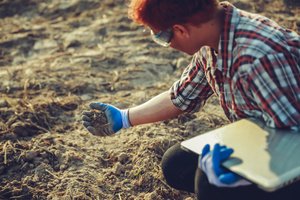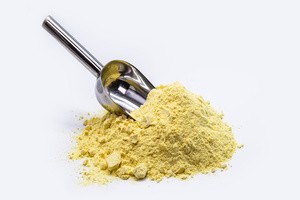When it comes to gardening, soil is one of the biggest determinants of success. In addition to choosing the right type of soil for your plants, it is essential to ensure that the soil has the right conditions for growth. Thankfully, you don’t have to wait until your plants grow to determine the health of your soil-instead, you can test your topsoil’s pH and bring it to an appropriate level before you plant to improve your chances of a great outcome.
Why Is pH Important?
Your soil must be able to provide the proper nutrition for your chosen plant to thrive. A soil’s pH is a measure of its acidity, and getting it right means that your plants will be able to better absorb essential nutrients from the soil. When your soil’s pH is too high, nutrients such as iron and phosphorus will be less available to your plants, but having a pH that is too low is also negative as it can be toxic to plants.
Testing Your Topsoil pH

The first step to take is testing your soil to find out its current pH, this will tell you if you need to increase or decrease its acidity. You can have your soil tested by your local extension office, or you can purchase a soil testing kit at your local garden center. Professional testing from your local county extension office is usually free or low in cost and tends to be more accurate than the kits available at gardening centers.
A good soil test will evaluate the pH level of your soil as well as its basic texture, such as silt, clay or sand. It will also calculate the available amounts of different nutrients, such as phosphorus, calcium, potassium and magnesium. Many soil tests will also make recommendations on how to raise the levels of all of these nutrients to foster optimum plant growth.
Soil tests should be carried out every three to five years. Although fall is considered the optimal season for taking soil samples, as it allows you enough time to get your soil in good shape ahead of spring, it can be done at any time of year.
A pH of 7 is considered neutral. A pH in the range of 0 to 7 is acidic, while a pH from 7 to 14 is alkaline. The ideal pH for soil used to grow vegetables and lawns is 6.5, which is slightly on the acidic side.
Correcting Soil pH
Here is a look at what you can do to improve your topsoil’s pH:
Raising pH in Acidic Soil
Consider one of the following methods to raise your soil’s pH if it is too acidic
Lime

Limestone is one of the most popular ways of raising the pH of soil that is too acidic. There are two main types of limestone soil additives that you can buy. The first is calcitic limestone, which is made up mostly of calcium carbonate. The other option is dolomitic limestone, which introduces magnesium to the soil. These are both excellent choices that perform similarly well.
Lime products work better when they have been worked into the soil instead of left on top of it. Many people choose to lime their lawns at the same time as core aeration and fall watering.
You can find liming products in the following formats:
Granular or Pellet-Type Limestone
These varieties of limestone are easy to spread but they take longer to break down than other formats.
Pulverized Lime
Pulverized lime is a type of fine lime powder that works very quickly. However, if you intend to use a spreader, it is important to be aware that it tends to cause clogs.
Hydrated Lime
Hydrated lime works faster than the other types, but it is very easy to overdo it. It’s important to follow the instructions on the package to the letter.
Wood Ash
Wood ash is an organic way to make soil less acidic. It can simply be sprinkled across the top of the soil and then mixed in to around a foot deep. This is a long-term approach that must be used in the form of small applications across several years, but it is very effective. Moreover, if you have a fireplace, it is a good way to recycle your ashes.
Lowering pH in Alkaline Soil
Consider one of the following methods to lower your soil’s pH if it is too alkaline.
Sulfur

Elemental sulfur is one of the most popular ways of making soil more acidic. Relatively safe and very affordable, sulfur can be spread across the top of the soil, taking care not to exceed 2 pounds for every 100 square feet of land. Keep in mind that sulfur is very slow acting and needs time to work.
Mulches and Compost
For a more natural approach, consider using mulches or compost. As organic matter breaks down, it usually increases the acidity of soil, which means that using organic compost mulch regularly will help bring your soil’s pH level back to the desired range.
Sphagnum Peat
Sphagnum peat is a great way of introducing organic matter into your soil while improving its water retention properties. Work a 2-inch layer of sphagnum peat into the soil to a depth of around 1 foot. If you need to cover a particularly large area, consider using a tiller.
Acidifying Fertilizer
There are lots of fertilizers on the market that contain ammonia, amino acids or urea, all of which can acidify the soil in your yard over time.
Aluminum Sulfate and Iron Sulfate
Aluminum sulfate and iron sulfate are fast-acting products, but it is important to keep in mind that they can also cause damage by introducing elements that build up in soil. Take care to avoid exceeding 5 pounds per 100 square feet when applying these two chemicals.
Reach Out to Dirt Connections
If you are looking for the right type of dirt to suit your gardening projects, reach out to the soil professionals at Dirt Connections. We deliver high-quality topsoil and dirt to residential and commercial sites throughout Northern Virginia and will be happy to advise you on the right materials for your project.
Summary

Dirt Connections was started with one goal in mind: providing quality residential and commercial construction services to clients on time and on budget. Reach out for more information on how we can support your next project.
For your convenience our estimates are free and by appointment. Call 703-940-9949 for a free estimate today!









































